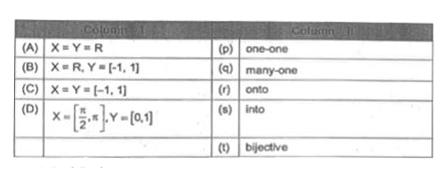Let f:N→Z be a function defined as f(x)=x−1000. Show that f is an into function.
Let f(x)=y=x−1000
⇒x=y+1000=g(y) (say)
Here g(y) is defined for each y∈Z, but g(y)∉N for y≤−1000.
Hence f is into.
Topper's Solved these Questions
- BOOK - CENGAGE ENGLISHCHAPTER - RELATIONS AND FUNCTIONSEXERCISE - Solved Examples15videos
RELATIONS AND FUNCTIONS
- BOOK - CENGAGE ENGLISHCHAPTER - RELATIONS AND FUNCTIONSEXERCISE - CONCEPT APPLICATION EXERCISE 1.115videos
RELATIONS AND FUNCTIONS
- BOOK - CENGAGE ENGLISHCHAPTER - PROPERTIES AND SOLUTIONS OF TRIANGLEEXERCISE - Archives (Numerical Value Type)3videos
PROPERTIES AND SOLUTIONS OF TRIANGLE
- BOOK - CENGAGE ENGLISHCHAPTER - SCALER TRIPLE PRODUCTS EXERCISE - DPP 2.311videos
SCALER TRIPLE PRODUCTS
Similar Questions
Let f: R→R be a function defined as f (x) = 3x+ 7 , x∈R . Show that f is an onto functions.
View SolutionLet f:X→Y be a function defined by f(x)=sinx.
 View Solution
View SolutionIf f:R→R be the function defined by f(x)=4x3+7 , show that f is a bijection.
View SolutionIf f:R→R be the function defined by f(x)=4x3+7, show that f is a bijection.
View SolutionLet f:N→S be a function defined as f(x)=9x2+6x−5. Show that f:N→S, where S is the range of f , is invertible. Find the inverse of f and hence f−1(43)andf−1(163)
View SolutionLet f:N→R be a function defined as f(x)=4x2+12x+15. Show that f:N→S, where S is the range of f is invertible. Also find the inverse of f
View SolutionProve that the function defined by f(x)=tanxis a continuous function.
View SolutionLet f:N→Rbe a function defined as f(x)=4x2+12x+15. Show that f:N→S, where, S is the range of f, is invertible. Find the inverse of f.
View SolutionIf f:R→R be the function defined by f(x)=4x3+7, show that f is a bijection.
View SolutionLet f:R→R be a function defined by f(x)=x2−x21+x2. Then:
View Solution

